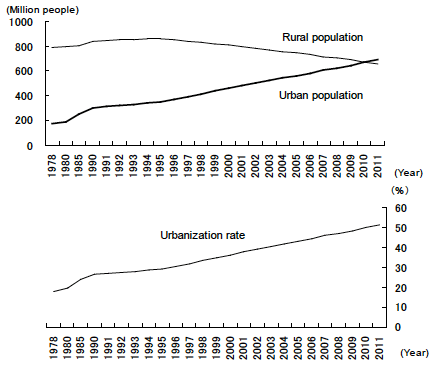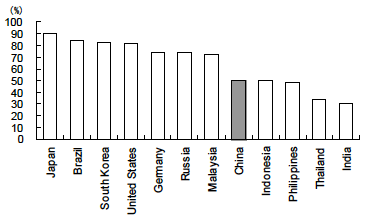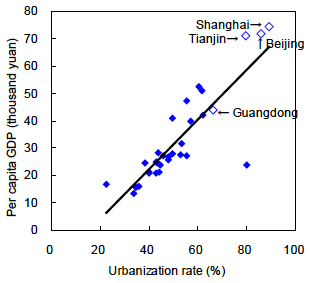In February 2012, the State Council of the People's Republic of China announced a policy to extend the coverage of household registration reform that allows for easier acquisition of urban household registrations from small cities to mid-sized ones. Progress in this area will not only improve the social status of rural residents, but also contribute to economic growth by accelerating the speed of urbanization.
Desired reform of the household registration system
In China, since the establishment of the People's Republic in 1949, a strict dual structure between urban and rural areas has been built up under a household registration system that strictly limits the migration of people from the latter to the former. Even today, the social status of rural residents is low. The Constitution of the People's Republic of China stipulates that the people have the right to receive assistance from the state and society under circumstances such as old age, illnesses, and the loss of capacity to work, and that the state must develop social welfare, social relief, and medical and health services so that the people can enjoy these rights. In reality, however, rural residents have not yet been able to enjoy fully these basic public services provided by the state.
Under the current household registration system, rural residents are restricted in their freedom to choose their place of residence, and are only allowed to obtain a qualification for a "temporary residence permit," which is equivalent to a domestic visa, even if they find employment in an urban area. Migrant farmers (who work in cities but remain on their rural household registrations) are strictly limited in their employment opportunities, forced to work under harsh conditions such as low wages and long hours simply because they lack an urban household registration. Despite the fact that they pay taxes and fees of various kinds, as "temporary residents," they are not entitled to the public services that urban residents enjoy, such as medical insurance and compulsory education for their children. When they lose their jobs, they are ineligible to receive unemployment benefits. In addition, their children born in urban areas are not given an urban household registration and will still hold a rural household registration.
Newly announced "policy of clearly classified household registration transfer"
As rural residents and migrant farmers are increasingly becoming aware of their rights, calls for reforming the household registration system are growing. However, some large cities that are expected to face the pressure of further population concentration and increased financial burden as a result of the reform are very resistant to it. As a compromise between the two camps, in 1997, the Chinese government launched an experiment to reform the household registration system in some small cities, and has been implementing this in earnest since 2001. Based on its experiences so far, the State Council on February 23, 2012 announced the "Circular of the General Office of the State Council on Actively and Steadily Promoting the Reform of the Household Registration Administration System" (Circular [2011] No. 9, hereinafter the "Circular"), which includes a policy to extend the subject cities to include mid-sized ones.
The Circular classifies the cities subject to the reform into three categories--large, mid-sized, and small--and presents a "policy of clearly classified household registration transfer," which tightens the application standards in proportion to city size (see Note).
First, in the case of small cities, those with legitimate and stable occupations and addresses (including rented accommodations) can apply for permanent residence status locally, including their spouses, unmarried children, and parents living together. Small cities are able to decide the specific conditions for the scope of a legitimate and stable occupation, the period of residence, and the scope of a legitimate and stable address (including rented accommodations) according to their receptive capacity.
Second, in the case of mid-sized cities, conditions have been added stipulating that residents should have stable occupations for three or more years and that their participation in the social security system should reach a certain number of years.
Finally, in the case of large cities, it has been decided that the population size should be limited to a reasonable range and that the implementation and further development of the current urban household registration policy should be advanced. However, clear application standards for household registrations have not been specified.
In this way, in addition to confirming the past policies for small and large cities, the Circular has added a new policy of accelerating the reform for mid-sized cities.
In addition, it includes policies of "securing rural residents' rights and interests regarding land based on the law" and "focusing on solving the actual problems of migrant farmers."
With respect to the former, the Circular sets forth the following: "The right of rural residents to use land to build houses and to lease land shall be protected by law. At present, for the settlement of migrant farmers in cities, their intentions shall invariably be fully respected regarding whether or not they renounce their residential land and the cultivated land, forests, and grass fields they have leased, and this redemption, or that in any other form, shall not be forced."
Concerning the latter, it stipulates that the "same rights enjoyed by local urban residents shall be granted to those who have transferred into urban household registrations." In addition, "the reciprocal enhancement of urbanization and the new farming village construction and a more harmonized development shall be promoted through the gradual homogenization of basic public services between urban and rural areas by accelerating the construction of new socialist farming villages, improving the production and living conditions of rural residents, and promoting a more balanced allocation of public resources. We shall respect rural residents' choice regarding whether to live in urban or rural areas."
Urbanization promoted by the reform of the household registration system
Given that factors preventing a demographic shift, including the household registration, are gradually being eliminated, a large-scale labor shift has already occurred. According to the "Statistical Communiqué of the People's Republic of China on the 2011 National Economic and Social Development" (the National Bureau of Statistics of China, February 22, 2012), the "fluid population," which has places of residence that differ from that of its household registration, had reached 230 million people by the end of 2011, of which 159 million people were migrant farmers. While the urban population increased from 172 million people to 691 million people from 1978 to 2011, reflecting the migration of labor from the rural areas to the urban areas, the rural population decreased from 790 million people to 657 million people. As a result, the urbanization rate (the ratio of the urban population to the total population) rose from 17.9% to 51.3% (Figure 1).

However, the urbanization rate in China is still low compared with that in other countries, developed nations in particular (Figure 2). It is hoped that a virtuous cycle of urbanization and economic development will take root in the future through the further advancement of the reform of the household registration system (BOX).

BOX: Urbanization, the Engine that Leads Economic Growth
Urbanization is leading China's strong economic growth from both the supply and demand sides.
First, on the supply side, it creates numerous job opportunities and absorbs surplus labor in rural areas through the development of secondary and tertiary industries. The migration of labor from primary industries with lower productivity to secondary and tertiary industries with higher productivity also boosts that of the overall economy. In addition, the cluster effect that arises from the regional concentration of economic activities also helps increase productivity. The higher productivity associated with urbanization significantly contributes to economic growth and, in turn, higher income.
At the same time, on the demand side, if migrant workers become able to settle down with their families in urban areas through the reform of the household registration system, demand for housing will increase. Along with the population inflow, host cities need to enhance public services such as education and medical services, while increasing investments in infrastructure such as transportation, electricity, and water. Thus, urbanization is an effective means to increase domestic demand.
Reflecting these factors, there is a pronounced tendency for per capita GDP to be higher in areas with higher urbanization rates (Figure).



